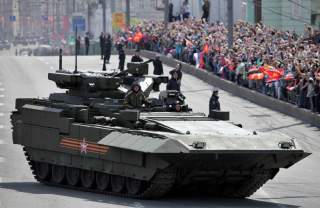Is Russia About to Make Tanks (As We Know Them) Obsolete?
Rise of the Terminators--literally.
Could the Russian Terminator series—also know as the Boyevaya Mashina Podderzhki Tankov—be the harbinger of future armored vehicle design?
Based on its experience in Ukraine, Georgia, Chechnya and Afghanistan, the Russian military certain believes so according to Ruslan Pukhov, director of the Moscow-based Centre for the Analysis of Strategies and Technologies (CAST). As such, Russia is mulling over the possibility of ditching the traditional tank—as it is currently conceptualized—and considering adopting a machine that is much more capable of defending itself against missile-equipped infantry and engaging other vehicles at stand-off ranges with anti-tank missiles.
Particularly, Russian experiences in Ukraine—where both sides are using upgraded Soviet-built tanks and anti-tank weapons—have shown that despite the best active, reactive and passive armor available, a tank will eventually be penetrated. “We discovered that no matter how skillful the crew, the tank would get up to ten hits,” Pukhov said during a luncheon at the Center for the National Interest in Washington, D.C.—which is the foreign policy think-tank that publishes The National Interest—on July 26. “Even if you have perfect armor—active, passive. In one case it will save you from one hit, in another case from two hits, but you’ll still get five hits and you’re done. That’s why now you’re supposed to have some kind of Tank 2.0.”
The Tank 2.0, as Pukhov describes it, is not the T-14 Armata—which despite its advanced unmanned turret and active protection systems—is still a more or less a conventional tank design. “I know Russians are thinking about this new tank and this tank is not Armata,” Pukhov said. “It’s what we call among us Boyevaya Mashina Podderzhki Tankov [Tank Support Fighting Machine]—but in fact it’s not a Podderzhki Tankov, but which can protect itself. So there is a serious debate about it.”
Later, during a one-on-one interview at the Center the same day, I asked Pukhov to elaborate on the Tank 2.0 concept. Pukhov said that traditionally, infantry has protected tanks—particularly in built up urban areas—but given the speed of modern armored vehicles, that is no longer possible in many cases. But while during previous eras tanks were more or less protected against weapons like rocket propelled grenades and anti-tank missiles, the latest generation of those weapons can punch through even the toughest armor.
As an example, Pukhov cited a particular battle in Eastern Ukraine where—even when operating under ideal conditions—a tank force fighting under the banner of Kremlin-backed separatist forces was all but annihilated by rocket-propelled grenades. If even a small force of anti-tank missile-equipped infantry could decimate a tank column, the take-away for the Russians was that they needed to rethink the entire concept of the tank. “That’s why we have the concept of the Tank 2.0,” Pukhov said. “We have a prototype of this machine that’s called the fighting vehicle to support tank attack—Terminator.”
There have been two versions of the Terminator concept that have been developed thus far. Another version that is based on the Armata chassis is said to be in development. “Russia also plans to develop its tank support fighting vehicle dubbed the Terminator-3 on the basis of the country’s latest Armata tanks,” Oleg Sienko, a senior manager with Uralvagonzavod Corporation told state-owned RIA Novosti earlier this year. “We will [produce them]. We have a concept for developing vehicles on the basis of the Armata platform.”
The name Boyevaya Mashina Podderzhki Tankov is a misnomer, Pukhov said. The Terminator will not be supporting other tanks—it will be an entirely new type of tank in its own right. However, Pukhov said that while prototypes of the new vehicle exist, the concept still needs to be refined before it is ready for prime time. Particularly, refinements are needed in its sensor suite to maximize situational awareness without exposing the crew to incoming fire. “Unfortunately, neither the concept nor the technologies are ready,” Pukhov said. “But the era of new tanks is very close.”
Michael Kofman, a research scientist specializing in Russian military affairs at CNA Corporation in Arlington, Virginia, said that he was skeptical about the Terminator’s prospects. “Neither of the two heavy tank support vehicles Russia has designed have been procured by either its own Ministry of Defense or anyone else—which should tell you something,” Kofman said. “How many Terminator 2s has UralVagonZavod sold? Zero.”
If and when the Terminator is ultimately fielded, the vehicle would be able to engage large groups of massed infantry in built-up areas with a combination of missiles and automatic cannon fire. “We need it badly,” Pukhov said. “Believe it or not, we’re not going to project force, we need to protect our territory.”
Dave Majumdar is the defense editor of The National Interest. You can follow him on Twitter @DaveMajumdar.
Image: Creative Commons/Flickr.

